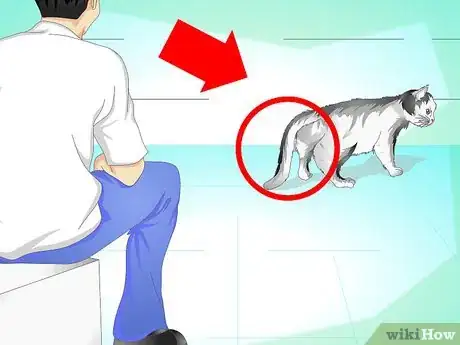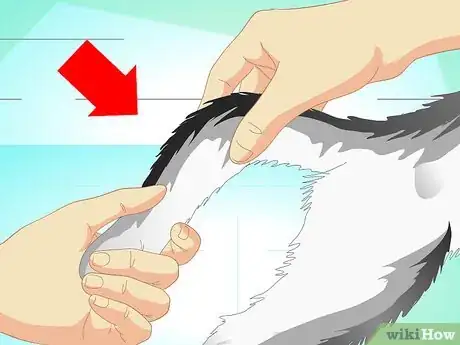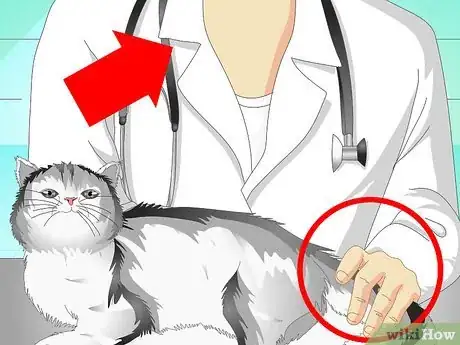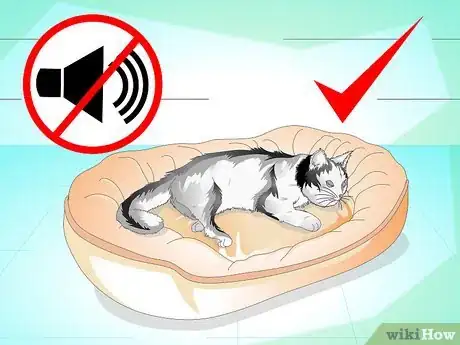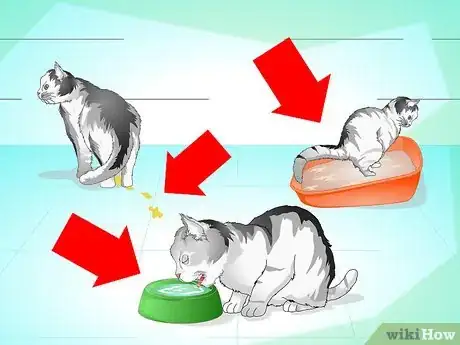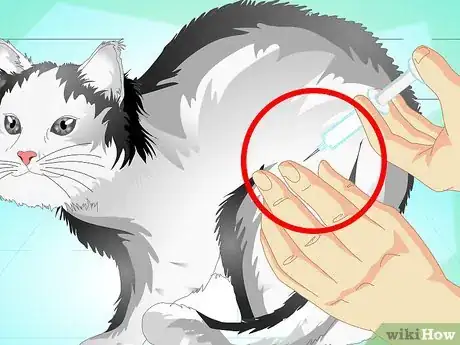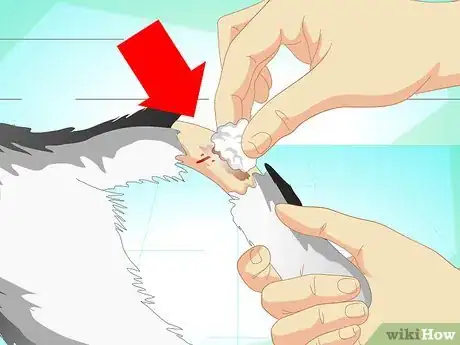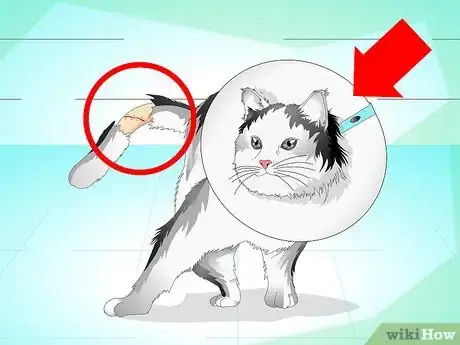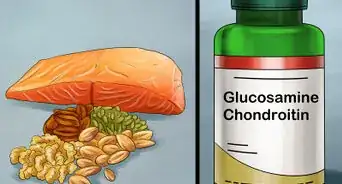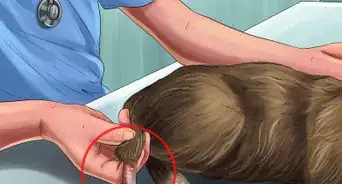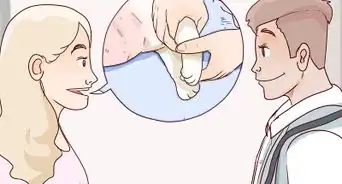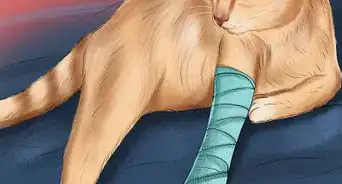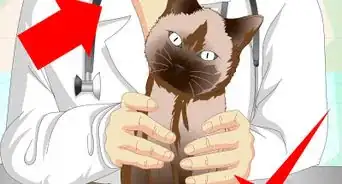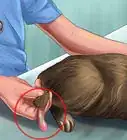This article was co-authored by Pippa Elliott, MRCVS. Dr. Elliott, BVMS, MRCVS is a veterinarian with over 30 years of experience in veterinary surgery and companion animal practice. She graduated from the University of Glasgow in 1987 with a degree in veterinary medicine and surgery. She has worked at the same animal clinic in her hometown for over 20 years.
There are 10 references cited in this article, which can be found at the bottom of the page.
wikiHow marks an article as reader-approved once it receives enough positive feedback. In this case, 92% of readers who voted found the article helpful, earning it our reader-approved status.
This article has been viewed 499,731 times.
Cats frequently get into mischief, whether they live inside, outside, or go back and forth. It's not surprising then that cats can end up with a variety of injuries, including damage to the tail. If your cat comes home and will not lift his tail or it seems bent or broken, your cat may have a tail injury or even a broken tail. You may even see an open wound, blood or bone. Cats most commonly damage their tails from crushing (an item falling on it or door closing on it), pulling (getting stuck then the cat tries to run away, young children, abusers), or both.[1] Once you've determined whether the cat's tail is broken, learn to care for the cat during the healing period.
Steps
Determining if the Cat's Tail is Broken
-
1Watch your cat's behavior. Your cat's changed behavior might be one of the first signs you notice that alerts you to a tail injury. Your cat may begin dragging his tail or keeping it low to the ground all the time, dribbling urine randomly, or having diarrhea. Your cat may begin walking unevenly or losing coordination in his back legs.[2]
- Dribbling urine and having diarrhea are not symptoms of a broken tail on their own. If the tail injury was severe enough to cause these signs, the cat will definitely be dragging the tail.
-
2Examine the cat's tail for injury. Gently feel along the length of the tail. Signs of injury or break include tender, swollen or bent areas. If you notice redness, tenderness, and swelling with fluid underneath, there may be an abscess, or pocket of pus, forming on your cat’s tail. If there is exposed bone or if the skin has been stripped from the tail leaving only bone this is called a ‘degloving’ injury.[3]
- If you happen to notice a hard, non-painful kink in your cat’s tail, it’s probably because he was born with the kink in the tail or it's an old, already healed injury.
- Never pull or try to remove a severed portion of tail since there are tough tendons and sensitive nerves. If you pull or stretch the tendons, you'll damage the use of the tail, hind limbs, bladder and bowel functions. It may also cause arterial bleeding, which is difficult to control and potentially life-threatening for your cat.
Advertisement -
3Take your cat to the vet if you suspect a tail injury. The vet can address the injury without additional damage to the tail. Your cat may need a partial or full amputation of his tail if he has a degloving injury, deep cut, or if his tail is deeply or mostly severed.[4] Your vet can also prescribe antibiotics to prevent infection which is highly likely with any open wound. Even if there are no external wounds, the vet can check your cat for other injuries. The vet may find neurologic damage from the tail being pulled during the accident.[5]
- The vet will examine the tail for signs of physical or neurological damage. If the vet suspects nerve damage, your cat may have an electromyogram test. Anal sphincter and tail muscles are tested for nerve input. This lets the vet know if the tail will be able to recover.
- Your cat may still be in pain when you bring him to the vet's office. Stay close to him and speak in gentle comforting tones. You may want to loosely wrap your cat in a towel and place him in his carrier when you bring him to the vet's. This will calm him.[6]
-
4Understand treatments. Depending on where and how the tail is injured, your veterinarian will determine surgery or another treatment. If the tail is paralyzed, but your cat can still walk, the vet will probably amputate the tail. If the end of the tail has a break that's not causing problems for your cat, the vet may tell you to let it heal on its own.[7]
- Your cat may need to stay at the veterinarian's for a few days to either rest and heal, or to determine the extent of the damage to the tail.
- If your cat's tail must be amputated, don't worry. It may take him a while to adjust to the lack of nerve sensation and change in balance. But, your cat will adapt to the change and his mobility won't suffer in the long run.[8]
Caring For the Cat
-
1Allow your cat to rest in a quiet space. Keep the cat inside to let him rest and prevent further trauma to his injuries.[9] Try putting your cat in a small room (like a bedroom, bathroom, or laundry room). This way, you can easily find him, check on the injury, and administer medications.
- Cats that are sick or injured often prefer to be away from children, other pets and a lot of noise or activity.
-
2Monitor your cat's habits. You'll need to pay attention to your cat’s appetite, water intake and litter box habits. Tail injuries can sometimes affect bladder or bowel functions. If your cat is leaking urine or feces or not urinating or defecating at all, he could have nerve damage affecting these functions.
-
3Give your cat medication. It's easiest to remember if you give medications on a schedule. You'll probably need to give antibiotics to prevent infections for any open wounds. Only give pain medication if your vet instructs you and gives a prescription. Never give over-the-counter pain medications.
- Many of these, like aspirin, or tylenol, are very dangerous to give to cats. They can have severe, even fatal, side effects in cats.[12]
-
4Keep any wounds or incisions clean. Check the wound at least once a day. Your cat may soil himself with urine or feces since it may be too painful to lift his tail or if there's nerve damage. Sometimes wounds will have crusted blood, discharge, hair, litter, or other debris stuck to or around them. You may need to clean the wounds gently with lukewarm water or very diluted betadine or chlorhexidine solutions, and some gauze or a washcloth. Tail wounds usually don't need to be bandaged.
- Don't use soap and peroxide since they're irritating and damaging to tissues. If you see dry scabs, remember that they're good and don't scrub or pull them off.
-
5Watch for infection. Whether or not you take your cat to the vet you will want to monitor the injury (or surgery) site very carefully. Don't let your cat lick any wounds. While there are some compounds in saliva that can help heal wounds[13] , excessive licking can irritate the skin and bacteria from the mouth can cause serious infections.[14] Signs of infected wounds are redness, warmth, swelling, and discharge that is white, green or yellow in color.
- You may want to keep an Elizabethan type collar on your cat to keep him from licking the injury. It could take up to 2-3 weeks for a tail fracture to heal, depending on the severity of the injury. Note that it may not heal perfectly, leaving a kink in the tail, but there should be no pain. All open wounds should also close up.
Expert Q&A
Did you know you can get expert answers for this article?
Unlock expert answers by supporting wikiHow
-
QuestionCan you fix a cat's broken tail?
 Pippa Elliott, MRCVSDr. Elliott, BVMS, MRCVS is a veterinarian with over 30 years of experience in veterinary surgery and companion animal practice. She graduated from the University of Glasgow in 1987 with a degree in veterinary medicine and surgery. She has worked at the same animal clinic in her hometown for over 20 years.
Pippa Elliott, MRCVSDr. Elliott, BVMS, MRCVS is a veterinarian with over 30 years of experience in veterinary surgery and companion animal practice. She graduated from the University of Glasgow in 1987 with a degree in veterinary medicine and surgery. She has worked at the same animal clinic in her hometown for over 20 years.
Veterinarian The weak point in a cat's tail is the ligaments holding the line of small bones together. It is these ligaments that usually snap, leading to a kink in the tail. It's difficult (and usually not necessary) to fix the ligaments, so whilst the cat has a permanently bent tail this is something they can live with.
The weak point in a cat's tail is the ligaments holding the line of small bones together. It is these ligaments that usually snap, leading to a kink in the tail. It's difficult (and usually not necessary) to fix the ligaments, so whilst the cat has a permanently bent tail this is something they can live with. -
QuestionWhy is my cat's tail hanging limp?
 Pippa Elliott, MRCVSDr. Elliott, BVMS, MRCVS is a veterinarian with over 30 years of experience in veterinary surgery and companion animal practice. She graduated from the University of Glasgow in 1987 with a degree in veterinary medicine and surgery. She has worked at the same animal clinic in her hometown for over 20 years.
Pippa Elliott, MRCVSDr. Elliott, BVMS, MRCVS is a veterinarian with over 30 years of experience in veterinary surgery and companion animal practice. She graduated from the University of Glasgow in 1987 with a degree in veterinary medicine and surgery. She has worked at the same animal clinic in her hometown for over 20 years.
Veterinarian
-
QuestionWhat happens if a cat loses its tail?
 Pippa Elliott, MRCVSDr. Elliott, BVMS, MRCVS is a veterinarian with over 30 years of experience in veterinary surgery and companion animal practice. She graduated from the University of Glasgow in 1987 with a degree in veterinary medicine and surgery. She has worked at the same animal clinic in her hometown for over 20 years.
Pippa Elliott, MRCVSDr. Elliott, BVMS, MRCVS is a veterinarian with over 30 years of experience in veterinary surgery and companion animal practice. She graduated from the University of Glasgow in 1987 with a degree in veterinary medicine and surgery. She has worked at the same animal clinic in her hometown for over 20 years.
Veterinarian
Warnings
- Only follow this guide if your cat has a new kink in his tail. Some breeds of cats have naturally kinked tails which are not broken and will not need to be treated.⧼thumbs_response⧽
References
- ↑ Lussier, Bertrand: Tail Paralysis. In Cote, E. (ed): Clinical Veterinary Advisor: Dogs and Cats Ed 1 St. Louis, Elsevier, 2007, pp 1063-1064.
- ↑ http://www.veterinarypartner.com/Content.plx?P=A&A=1322&S=0&EVetID=3001644
- ↑ http://www.pets4homes.co.uk/pet-advice/tail-injuries-in-cats.html
- ↑ Tobias, Karen M. Veterinary Surgery: Small Animal. Published by Saunders, 2012
- ↑ Lussier, Bertrand: Tail Paralysis. In Cote, E. (ed): Clinical Veterinary Advisor: Dogs and Cats Ed 1 St. Louis, Elsevier, 2007, pp 1063-1064.
- ↑ https://www.avma.org/public/EmergencyCare/Pages/Handling-an-Injured-Pet.aspx
- ↑ http://www.pets4homes.co.uk/pet-advice/tail-injuries-in-cats.html
- ↑ http://www.purina.co.uk/content/your-cat/helping-to-keep-your-cat-healthy/special-cat-needs/coping-with-amputation-in-cats
- ↑ http://www.petplace.com/article/cats/diseases-conditions-of-cats/emergency-trauma-urgent-care/tail-trauma-in-cats
- ↑ http://www.petplace.com/article/cats/diseases-conditions-of-cats/emergency-trauma-urgent-care/tail-trauma-in-cats
- ↑ http://www.petplace.com/article/cats/diseases-conditions-of-cats/emergency-trauma-urgent-care/tail-trauma-in-cats
- ↑ http://www.vcahospitals.com/main/pet-health-information/article/animal-health/pain-management-for-cats/6584
- ↑ Brand HS1, Ligtenberg AJ, Veerman EC. Saliva and wound healing. Monogr Oral Sci. 2014;24:52-60. doi: 10.1159/000358784. Epub 2014 May 23.
- ↑ Lilenbaum W1, Esteves AL, Souza GN. Prevalence and antimicrobial susceptibility of staphylococci isolated from saliva of clinically normal cats. Lett Appl Microbiol. 1999 Jun;28(6):448-52.
About This Article
Before you treat your cat's broken tail, confirm that it's actually broken by feeling gently along the tail for swollen, bent, or tender areas. Then, take your cat to the vet to get a proper diagnosis and a treatment plan. Once you return home, keep the cat in a small room, like a bedroom or bathroom, so it can rest. You should also clean any wounds with warm water, and give your cat antibiotics to avoid infection. If you notice your cat's tail is red or swollen, take it back to the vet as these may be signs of an infection. For tips on how to spot a broken tail from your cat's behavior, keep reading!
